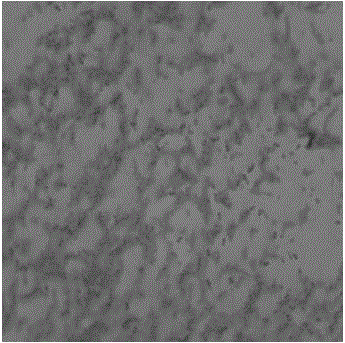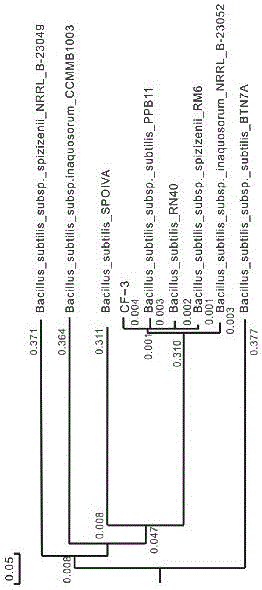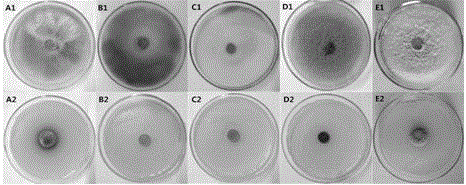Bacillus subtilis CF-3 and culture method thereof
A Bacillus subtilis, CF-3 technology, applied to the newly screened Bacillus subtilis CF-3 and its culture field, can solve the problems affecting the commercial application of biocontrol bacteria, less research on control effects, and narrow antibacterial spectrum. , to achieve the effect of high potency, broad antibacterial spectrum and easy preparation
- Summary
- Abstract
- Description
- Claims
- Application Information
AI Technical Summary
Problems solved by technology
Method used
Image
Examples
Embodiment 1
[0018] Embodiment 1: Separation and purification of Bacillus subtilis CF-3
[0019] The bacillus subtilis strain is isolated and screened from purchased fermented bean curd by means of a dilution plate method. Put every piece of fermented bean curd (10 grams) into the Erlenmeyer flask that 100 milliliters of sterilized waters are housed and shake for 10 minutes, then serially dilute to 10 -6 times, to prepare dilutions; mix 1 ml of suspensions of different concentrations with NA solid medium cooled to 55-60°C and sterilize, pour it into a petri dish, and incubate it in a constant temperature incubator at 30°C for 24 hours; after the bacteria grow on the plate, pick a single colony and inoculate them on the NA solid medium for plate culture; then use the streak method to carry out mycelia inhibition experiments on pathogenic fungi, and select biocontrol bacterial strains with good inhibitory effect, and then In 20mL sterilized NA liquid medium, 37°C, 150rpm, shake flask cultur...
Embodiment 2
[0024] Embodiment 2: Identification of biological traits and physiological and biochemical characteristics of Bacillus subtilis CF-3
[0025] 1. Morphological characteristics:
[0026] The morphology of Bacillus subtilis CF-3 was found in electron microscope figure 1 , the colony of Bacillus subtilis cultured on a plate at 37°C for 24 hours was light yellow, round, smooth and translucent to opaque, with neat edges and thicker than the center; Gram staining was positive, and the cells were rod-shaped, with Flagella throughout, uncapsulated. Microscope photos are attached figure 1 .
[0027] 2. Physiological and biochemical characteristics:
[0028]The optimum temperature for the growth of Bacillus subtilis CF-3 is 37°C, and the optimum pH is 7.0-7.2. The rest are shown in Table 1.
[0029] Table 1 Physiological and biochemical characteristics of Bacillus subtilis CF-3
[0030]
[0031]
[0032] Note: "+" means positive or growth, "-" means negative or no growth
Embodiment 3
[0033] Example 3: Sequence determination and analysis of 16S rDNA of Bacillus subtilis CF-3
[0034] 1. Extraction of PCR template DNA:
[0035] Extracted by the DNA extraction kit produced by TAKARA Biotechnology Company
[0036] 2.16S rDNA gene PCR amplification:
[0037] PCR primers were produced by TAKARA Biotechnology Company
[0038] Upstream primer Primer A: 5'-GAGCGGATAACAATTTCACACAGG-3' (SEQ ID NO:2)
[0039] Downstream primer Primer B: 5'-CGCCAGGGTTTTTCCCAGTCACGAC-3' (SEQ ID NO:3)
[0040] The PCR reaction system is shown in Table 2:
[0041] Table 2 PCR reaction system
[0042]
[0043] PCR amplification cycle conditions: first cycle at 94°C for 5 minutes; then cycle 30 times in the order of 94°C for 1 minute, 50-55°C for 1 minute, and 72°C for 1.5 minutes; finally cycle at 72°C for 5 minutes.
[0044] 3. Sequence determination:
[0045] After the PCR product was purified, it was sent to Sangon Bioengineering (Shanghai) Co., Ltd. for sequencing. The sequen...
PUM
 Login to View More
Login to View More Abstract
Description
Claims
Application Information
 Login to View More
Login to View More - R&D
- Intellectual Property
- Life Sciences
- Materials
- Tech Scout
- Unparalleled Data Quality
- Higher Quality Content
- 60% Fewer Hallucinations
Browse by: Latest US Patents, China's latest patents, Technical Efficacy Thesaurus, Application Domain, Technology Topic, Popular Technical Reports.
© 2025 PatSnap. All rights reserved.Legal|Privacy policy|Modern Slavery Act Transparency Statement|Sitemap|About US| Contact US: help@patsnap.com



